5G NR-TM and FRC Waveform Generation
This example shows how to generate standard-compliant 5G NR test models (NR-TMs) and uplink and downlink fixed reference channels (FRCs) for frequency range 1 (FR1) and frequency range 2 (FR2). For the NR-TM and FRC waveform generation, you can specify the NR-TM or FRC name, the channel bandwidth, the subcarrier spacing, and the duplexing mode.
Introduction
The 3GPP 5G NR standard defines sets of link and waveform configurations for the purposes of conformance testing. Two specific types of downlink conformance waveforms are NR test models (NR-TM), for the purpose of base station (BS) RF testing, and downlink fixed reference channels (FRC), for user equipment (UE) input testing.
The NR-TMs for FR1 are defined in TS 38.141-1 Section 4.9.2, and the NR-TMs for FR2 are defined in TS 38.141-2 Section 4.9.2.
They are used in a range of RF tests, including:
BS output power
Timing alignment error (TAE)
Occupied bandwidth emissions
Adjacent channel leakage ratio (ACLR)
Operating band unwanted emissions
Transmitter spurious emissions
Transmitter intermodulation
Specific test models are aimed at specific sets of measurements.
The physical downlink shared channel (PDSCH) FRC for FR1 are defined in TS 38.101-1 Annex A.3, and for FR2 are defined in TS 38.101-2 Annex A.3.
They are used in a number of UE tests, including:
UE receiver requirements
Maximum UE input level testing
The physical uplink shared channel (PUSCH) FRC for FR1 and FR2 are defined in TS 38.104 Annex A.
They are used in a number of base station reception tests, including:
Reference sensitivity
Adjacent channel selectivity (ACS)
In-band and out-of-band blocking
Receiver intermodulation
In-channel selectivity
Dynamic range
Performance requirements
NR-TMs and FRCs are defined across a standardized set of transmission bandwidth configurations for a valid range of channel bandwidth and subcarrier spacing combinations.
This reference application example uses the MATLAB class hNRReferenceWaveformGenerator. This class provides access to the bandwidth configuration tables, the Release 15, 16, and 17 test model and FRC lists, and provides baseband waveform generation and resource grid visualization.
The hNRReferenceWaveformGenerator class contains two constant MATLAB table properties. The FR1BandwidthTable property contains the FR1 transmission bandwidth configurations defined in TS 38.104 Table 5.3.2-1. See also the FR1 maximum transmission bandwidth configurations defined in TS 38.101-1 Table 5.3.2-1. The FR2BandwidthTable property contains the FR2 transmission bandwidth configurations defined in TS 38.104 Tables 5.3.2-2 and 5.3.2-3. See also the FR2 maximum transmission bandwidth configurations defined in TS 38.101-2 Table 5.3.2-1.
% NR transmission bandwidth configurations
fr1bandwidthtable = hNRReferenceWaveformGenerator.FR1BandwidthTablefr1bandwidthtable=3×15 table
5MHz 10MHz 15MHz 20MHz 25MHz 30MHz 35MHz 40MHz 45MHz 50MHz 60MHz 70MHz 80MHz 90MHz 100MHz
____ _____ _____ _____ _____ _____ _____ _____ _____ _____ _____ _____ _____ _____ ______
15kHz 25 52 79 106 133 160 188 216 242 270 NaN NaN NaN NaN NaN
30kHz 11 24 38 51 65 78 92 106 119 133 162 189 217 245 273
60kHz NaN 11 18 24 31 38 44 51 58 65 79 93 107 121 135
fr2bandwidthtable = hNRReferenceWaveformGenerator.FR2BandwidthTable
fr2bandwidthtable=4×7 table
50MHz 100MHz 200MHz 400MHz 800MHz 1600MHz 2000MHz
_____ ______ ______ ______ ______ _______ _______
60kHz 66 132 264 NaN NaN NaN NaN
120kHz 32 66 132 264 NaN NaN NaN
480kHz NaN NaN NaN 66 124 248 NaN
960kHz NaN NaN NaN 33 62 124 148
The hNRReferenceWaveformGenerator class also contains two constant properties which list the test model names for FR1 (TS 38.141-1 Section 4.9.2) and test model names for FR2 (TS 38.141-2 Section 4.9.2).
% Release 15, 16, and 17 NR-TM test models for FR1 and FR2
fr1testmodels = hNRReferenceWaveformGenerator.FR1TestModelsfr1testmodels = 10x1 string
"NR-FR1-TM1.1"
"NR-FR1-TM1.2"
"NR-FR1-TM2"
"NR-FR1-TM2a"
"NR-FR1-TM2b"
"NR-FR1-TM3.1"
"NR-FR1-TM3.1a"
"NR-FR1-TM3.1b"
"NR-FR1-TM3.2"
"NR-FR1-TM3.3"
fr2testmodels = hNRReferenceWaveformGenerator.FR2TestModels
fr2testmodels = 5x1 string
"NR-FR2-TM1.1"
"NR-FR2-TM2"
"NR-FR2-TM2a"
"NR-FR2-TM3.1"
"NR-FR2-TM3.1a"
For the downlink FRCs, the class contains additional constant properties which list the downlink FRC names for FR1 (TS 38.101-1 Annex A.3) and for FR2 (TS 38.101-2 Annex A.3).
% Release 15, 16, and 17 downlink fixed reference channels for FR1 and FR2
fr1downlinkfrc = hNRReferenceWaveformGenerator.FR1DownlinkFRCfr1downlinkfrc = 4x1 string
"DL-FRC-FR1-QPSK"
"DL-FRC-FR1-64QAM"
"DL-FRC-FR1-256QAM"
"DL-FRC-FR1-1024QAM"
fr2downlinkfrc = hNRReferenceWaveformGenerator.FR2DownlinkFRC
fr2downlinkfrc = 3x1 string
"DL-FRC-FR2-QPSK"
"DL-FRC-FR2-16QAM"
"DL-FRC-FR2-64QAM"
For the uplink FRCs, the class contains two constant properties which list the uplink FRC names for FR1 and FR2 (TS 38.104 Annex A).
% Release 15 uplink fixed reference channels for FR1 and FR2
fr1uplinkfrc = hNRReferenceWaveformGenerator.FR1UplinkFRC fr1uplinkfrc = 89x1 string
"G-FR1-A1-1"
"G-FR1-A1-2"
"G-FR1-A1-3"
"G-FR1-A1-4"
"G-FR1-A1-5"
"G-FR1-A1-6"
"G-FR1-A1-7"
"G-FR1-A1-8"
"G-FR1-A1-9"
"G-FR1-A2-1"
"G-FR1-A2-2"
"G-FR1-A2-3"
"G-FR1-A2-4"
"G-FR1-A2-5"
"G-FR1-A2-6"
"G-FR1-A3-1"
"G-FR1-A3-2"
"G-FR1-A3-3"
"G-FR1-A3-4"
"G-FR1-A3-5"
"G-FR1-A3-6"
"G-FR1-A3-7"
"G-FR1-A3-8"
"G-FR1-A3-9"
"G-FR1-A3-10"
"G-FR1-A3-11"
"G-FR1-A3-12"
"G-FR1-A3-13"
"G-FR1-A3-14"
"G-FR1-A3-15"
⋮
fr2uplinkfrc = hNRReferenceWaveformGenerator.FR2UplinkFRC
fr2uplinkfrc = 37x1 string
"G-FR2-A1-1"
"G-FR2-A1-2"
"G-FR2-A1-3"
"G-FR2-A1-4"
"G-FR2-A1-5"
"G-FR2-A3-1"
"G-FR2-A3-2"
"G-FR2-A3-3"
"G-FR2-A3-4"
"G-FR2-A3-5"
"G-FR2-A3-6"
"G-FR2-A3-7"
"G-FR2-A3-8"
"G-FR2-A3-9"
"G-FR2-A3-10"
"G-FR2-A3-11"
"G-FR2-A3-12"
"G-FR2-A4-1"
"G-FR2-A4-2"
"G-FR2-A4-3"
"G-FR2-A4-4"
"G-FR2-A4-5"
"G-FR2-A4-6"
"G-FR2-A4-7"
"G-FR2-A4-8"
"G-FR2-A4-9"
"G-FR2-A4-10"
"G-FR2-A5-1"
"G-FR2-A5-2"
"G-FR2-A5-3"
⋮
For more information, access the help of hNRReferenceWaveformGenerator by typing 'doc hNRReferenceWaveformGenerator'.
NR-TM and PDSCH FRC Waveform Generation
Each PDSCH reference waveform is defined by a combination of:
NR-TM or FRC name
Channel bandwidth
Subcarrier spacing
Duplexing mode
Different NR-TMs are defined for FR1 and FR2. Depending on the test model purposes, NR-TMs have varying PDSCH characteristics. For example: full band, single modulation scheme, or full band, multiple modulation schemes with varying power boosting/deboosting or single, varying PRB allocation. Common features to all NR-TMs are: no SS burst, PDSCH mapping type A with one (FR2) or two (FR1) DM-RS positions per slot transmission, and a single PDCCH across two symbols with NCCE = 1. There is no transport or DCI coding used and the input to the PDSCH and PDCCH is all 0's or PN23. FDD NR-TM waveforms are 10 ms in length and TDD cases are 20 ms. PT-RS are specified for FR2 NR-TM.
By comparison, downlink FRC waveforms contain transport coded PDSCH using RV = 0. The reference PDSCH are not defined in slots which overlap the SS burst (slot 0 or slots 0 and 1). They use front loaded PDSCH mapping type A with 2 additional DM-RS positions. There is no FDM between the PDSCH and the DM-RS. The full-band PDSCH start at symbol 2 and the first 2 symbols in a slot contain a full occupied CORESET. The FRC waveforms generated in this example do not contain additional OCNG. Power levels for all resource elements are uniform. The transport block data source is ITU PN9.
The channel bandwidth and subcarrier spacing combination have to be a valid pair from the associated FR bandwidth configuration table. The standard only defines FR2 NR-TM and FRC for TDD but with this example you can also create FDD waveforms.
This MATLAB code creates an hNRReferenceWaveformGenerator object for the selected NR-TM or FRC configuration. You can use this object to generate the associated baseband waveform and to display the underlying PRB and subcarrier-level resource grids.
% Select the NR-TM or PDSCH FRC waveform parameters dlnrref ="NR-FR1-TM3.2"; % Model name and properties bw =
"10MHz"; % Channel bandwidth scs =
"15kHz"; % Subcarrier spacing dm =
"FDD"; % Duplexing mode ncellid =
1; % NCellID % Run this entire section to generate the required waveform
% Create generator object for the above NR-TM/PDSCH FRC reference model dlrefwavegen = hNRReferenceWaveformGenerator(dlnrref,bw,scs,dm,ncellid)
dlrefwavegen =
hNRReferenceWaveformGenerator with properties:
FR1BandwidthTable: [3x15 table]
FR2BandwidthTable: [4x7 table]
FR1TestModels: [10x1 string]
FR2TestModels: [5x1 string]
FR1DownlinkFRC: [4x1 string]
FR2DownlinkFRC: [3x1 string]
FR1UplinkFRC: [89x1 string]
FR2UplinkFRC: [37x1 string]
Config: [1x1 nrDLCarrierConfig]
IsReadOnly: 1
ConfiguredModel: {["NR-FR1-TM3.2"] ["10MHz"] ["15kHz"] ["FDD"] [1] ["17.8.0"]}
TargetRNTI: 1
% Generate waveform [dlrefwaveform,dlrefwaveinfo,dlresourceinfo] = generateWaveform(dlrefwavegen); % View transmission information about the set of PDSCH within the waveform dlresourceinfo.WaveformResources.PDSCH
ans=1×3 struct array with fields:
Name
CDMLengths
Resources
% View detailed information about one of the PDSCH sequences
dlresourceinfo.WaveformResources.PDSCH(1).Resourcesans=1×10 struct array with fields:
NSlot
TransportBlockSize
TransportBlock
RV
Codeword
G
Gd
ChannelIndices
ChannelSymbols
DMRSIndices
DMRSSymbols
DMRSSymbolSet
PTRSIndices
PTRSSymbols
PTRSSymbolSet
% Waveform sample rate (Hz)
samplerate = dlrefwaveinfo.Info.SampleRate samplerate = 15360000
plot(abs(dlrefwaveform)); title(sprintf('Magnitude of %s Baseband Waveform',dlnrref)); xlabel('Sample Index'); ylabel('Magnitude');
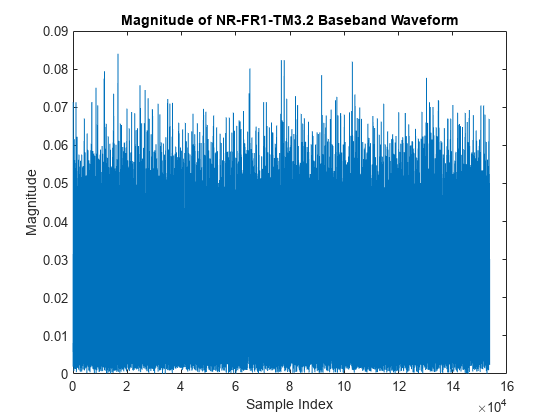
% Visualize the associated PRB and subcarrier resource grids
displayResourceGrid(dlrefwavegen);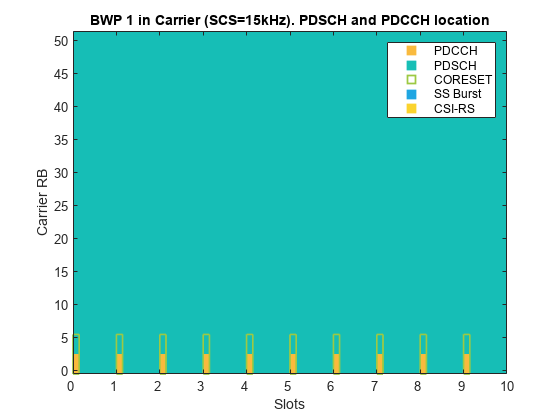
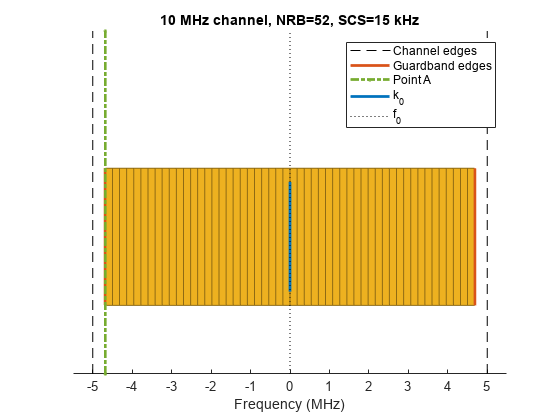
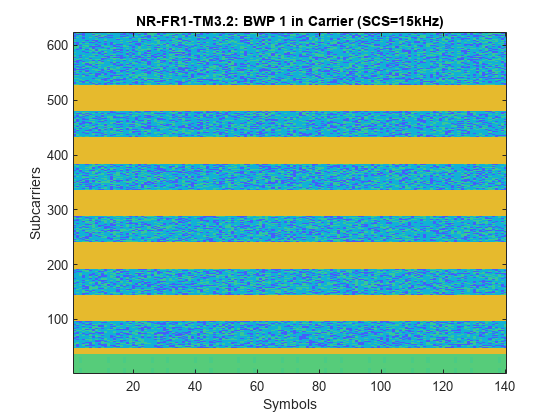
fullparameterset = dlrefwavegen.Config % Full low-level parameter setfullparameterset =
nrDLCarrierConfig with properties:
Label: 'NR-FR1-TM3.2'
FrequencyRange: 'FR1'
ChannelBandwidth: 10
NCellID: 1
NumSubframes: 10
InitialNSubframe: 0
WindowingPercent: 0
SampleRate: []
CarrierFrequency: 0
SCSCarriers: {[1x1 nrSCSCarrierConfig]}
BandwidthParts: {[1x1 nrWavegenBWPConfig]}
SSBurst: [1x1 nrWavegenSSBurstConfig]
CORESET: {[1x1 nrCORESETConfig]}
SearchSpaces: {[1x1 nrSearchSpaceConfig]}
PDCCH: {[1x1 nrWavegenPDCCHConfig]}
PDSCH: {[1x1 nrWavegenPDSCHConfig] [1x1 nrWavegenPDSCHConfig] [1x1 nrWavegenPDSCHConfig]}
CSIRS: {[1x1 nrWavegenCSIRSConfig]}
% Make the Config parameters writable and boost the power on all PDSCH DM-RS
dlrefwavegen = makeConfigWritable(dlrefwavegen)dlrefwavegen =
hNRReferenceWaveformGenerator with properties:
FR1BandwidthTable: [3x15 table]
FR2BandwidthTable: [4x7 table]
FR1TestModels: [10x1 string]
FR2TestModels: [5x1 string]
FR1DownlinkFRC: [4x1 string]
FR2DownlinkFRC: [3x1 string]
FR1UplinkFRC: [89x1 string]
FR2UplinkFRC: [37x1 string]
Config: [1x1 nrDLCarrierConfig]
IsReadOnly: 0
ConfiguredModel: {["NR-FR1-TM3.2"] ["10MHz"] ["15kHz"] ["FDD"] [1] ["17.8.0"]}
TargetRNTI: 1
% Set DM-RS power parameter on all the PDSCH pdscharray = [dlrefwavegen.Config.PDSCH{:}]; % Extract all PDSCH configs into an array [pdscharray.DMRSPower] = deal(3); % Boost the DM-RS power on all the PDSCH dlrefwavegen.Config.PDSCH = num2cell(pdscharray); % Reassign the updated PDSCH configs
PUSCH FRC Waveform Generation
Each PUSCH FRC reference channel definition in TS 38.104 Annex A explicitly defines a number of key parameters including:
Frequency range
Channel bandwidth
Subcarrier spacing
Code rate
Modulation
DM-RS configuration
Additionally, the associated receiver tests introduce some additional parameters that are not specified in the TS 38.104 Annex A tables, for example, the general test parameters defined in:
Table 8.2.1.1-1 (Conducted performance requirements for PUSCH without transform precoding)
Table 8.2.2.1-1 (Conducted performance requirements for PUSCH with transform precoding)
Table 11.2.2.1.1-1 (Radiated performance requirements for BS type 2-O for PUSCH without transform precoding)
Table 11.2.2.2.1-1 (Radiated performance requirements for BS type 2-O for PUSCH with transform precoding)
The parameter sets that are captured in the MATLAB reference waveform generator use the above specification sources. Since a given FRC can be used in different tests with different parameters requirements, the following general rules apply to the default generator configurations. All parameters can be modified after construction. Transform precoding is enabled for appropriate FRC. FR2 waveforms are TDD and 20ms in length, and FR1 waveforms are FDD and 10ms. The PUSCH FRC are defined with type A mapping, type B mapping, or, in some cases, either mapping type. In the latter case, type A mapping is configured. FR2 waveforms without transform precoding are configured with PT-RS, otherwise PT-RS are off. Scrambling identities are set to 0. Power levels for all resource elements are uniform. The transport block data source is ITU PN9 with RV = 0 i.e. no retransmissions.
This MATLAB code creates an hNRReferenceWaveformGenerator object for the selected PUSCH FRC configuration. Due to the large number of FRC, the live script FRC drop-down lists only those from section TS 38.104 A.1 (reference sensistivity, ACS, in-band blocking etc.) and A.2 (dynamic range). The performance test FRC defined in A.3, A.4, A.5 can be chosen by specifying the FRC name string directly in the code below. After the generator object is created, all configuration parameters can be changed by making them writable using the makeConfigWritable function.
% Select the PUSCH FRC waveform ulnrref ="G-FR1-A1-1"; % This live script down-drop list is preconfigured for TS 38.104 Annex A.1 and A.2 subsets % Possible overrides to Annex A definitions (empty values provide the Annex A defaults) bw = []; % Bandwidth override (5,10,15,20,25,30,40,50,60,70,80,90,100,200,400,800,1600,2000 MHz) scs = []; % Subcarrier spacing override (15,30,60,120,480,960 kHz) dm = []; % Duplexing mode override ("FDD","TDD") ncellid = []; % Cell identity override (used to control scrambling identities) % Run this entire section to generate the required waveform
% Create generator object for the above PUSCH FRC reference model ulrefwavegen = hNRReferenceWaveformGenerator(ulnrref,bw,scs,dm,ncellid)
ulrefwavegen =
hNRReferenceWaveformGenerator with properties:
FR1BandwidthTable: [3x15 table]
FR2BandwidthTable: [4x7 table]
FR1TestModels: [10x1 string]
FR2TestModels: [5x1 string]
FR1DownlinkFRC: [4x1 string]
FR2DownlinkFRC: [3x1 string]
FR1UplinkFRC: [89x1 string]
FR2UplinkFRC: [37x1 string]
Config: [1x1 nrULCarrierConfig]
IsReadOnly: 1
ConfiguredModel: {["G-FR1-A1-1"] [] [] ["FDD"] [0]}
TargetRNTI: 0
% Generate waveform [ulrefwaveform,ulrefwaveinfo,ulresourceinfo] = generateWaveform(ulrefwavegen); % View transmission information about the set of PUSCH within the waveform ulresourceinfo.WaveformResources.PUSCH
ans = struct with fields:
Name: 'PUSCH sequence for G-FR1-A1-1'
CDMLengths: [1 1]
Resources: [1x10 struct]
% View detailed information about one of the PUSCH sequences
ulresourceinfo.WaveformResources.PUSCH(1).Resourcesans=1×10 struct array with fields:
NSlot
TransportBlockSize
TransportBlock
RV
Codeword
G
Gd
ChannelIndices
ChannelSymbols
DMRSIndices
DMRSSymbols
DMRSSymbolSet
PTRSIndices
PTRSSymbols
PTRSSymbolSet
% Waveform sample rate (Hz)
samplerate = ulrefwaveinfo.Info.SampleRate samplerate = 7680000
plot(abs(ulrefwaveform)); title(sprintf('Magnitude of %s Baseband Waveform',ulnrref)); xlabel('Sample Index'); ylabel('Magnitude');
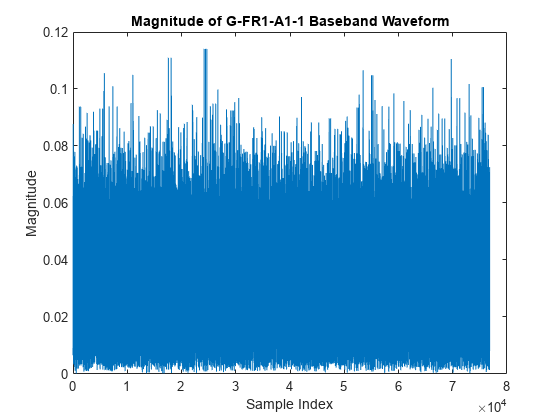
% Visualize the associated PRB and subcarrier resource grids
displayResourceGrid(ulrefwavegen);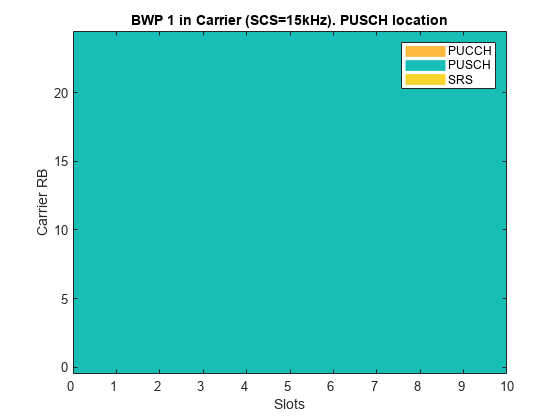
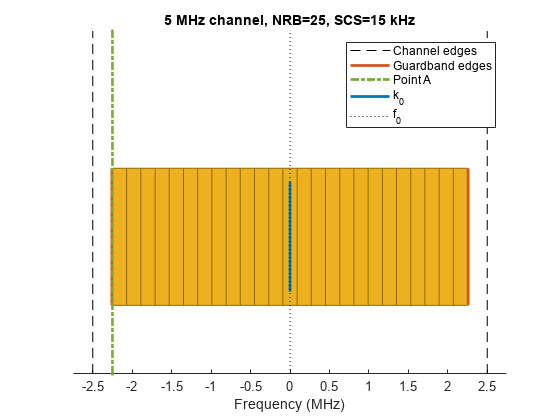
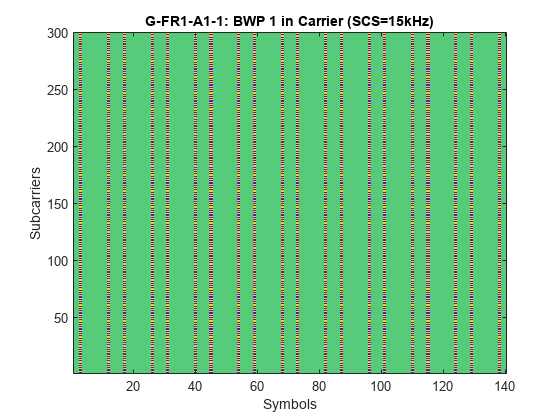
fullparameterset = ulrefwavegen.Config % Full low-level parameter setfullparameterset =
nrULCarrierConfig with properties:
Label: 'G-FR1-A1-1'
FrequencyRange: 'FR1'
ChannelBandwidth: 5
NCellID: 0
NumSubframes: 10
InitialNSubframe: 0
WindowingPercent: 0
SampleRate: []
CarrierFrequency: 0
SCSCarriers: {[1x1 nrSCSCarrierConfig]}
BandwidthParts: {[1x1 nrWavegenBWPConfig]}
IntraCellGuardBands: {[1x1 nrIntraCellGuardBandsConfig]}
PUSCH: {[1x1 nrWavegenPUSCHConfig]}
PUCCH: {[1x1 nrWavegenPUCCH0Config]}
SRS: {[1x1 nrWavegenSRSConfig]}
References
[1] 3GPP TS 38.101-1. “NR; User Equipment (UE) radio transmission and reception; Part 1: Range 1 Standalone.” 3rd Generation Partnership Project; Technical Specification Group Radio Access Network.
[2] 3GPP TS 38.101-2. “NR; User Equipment (UE) radio transmission and reception; Part 2: Range 2 Standalone.” 3rd Generation Partnership Project; Technical Specification Group Radio Access Network.
[3] 3GPP TS 38.104. “NR; Base Station (BS) radio transmission and reception.” 3rd Generation Partnership Project; Technical Specification Group Radio Access Network.
[4] 3GPP TS 38.141-1. “NR; Base Station (BS) conformance testing Part 1: Conducted conformance testing.” 3rd Generation Partnership Project; Technical Specification Group Radio Access Network.
[5] 3GPP TS 38.141-2. “NR; Base Station (BS) conformance testing Part 2: Radiated conformance testing.” 3rd Generation Partnership Project; Technical Specification Group Radio Access Network.
